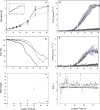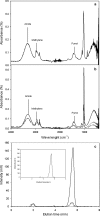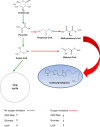The metabolic switch can be activated in a recombinant strain of Streptomyces lividans by a low oxygen transfer rate in shake flasks
- PMID: 30486842
- PMCID: PMC6260694
- DOI: 10.1186/s12934-018-1035-3
The metabolic switch can be activated in a recombinant strain of Streptomyces lividans by a low oxygen transfer rate in shake flasks
Abstract
Background: In Streptomyces, understanding the switch from primary to secondary metabolism is important for maximizing the production of secondary metabolites such as antibiotics, as well as for optimizing recombinant glycoprotein production. Differences in Streptomyces lividans bacterial aggregation as well as recombinant glycoprotein production and O-mannosylation have been reported due to modifications in the shake flask design. We hypothetized that such differences are related to the metabolic switch that occurs under oxygen-limiting conditions in the cultures.
Results: Shake flask design was found to affect undecylprodigiosin (RED, a marker of secondary metabolism) production; the RED yield was 12 and 385 times greater in conventional normal Erlenmeyer flasks (NF) than in baffled flasks (BF) and coiled flasks (CF), respectively. In addition, oxygen transfer rates (OTR) and carbon dioxide transfer rates were almost 15 times greater in cultures in CF and BF as compared with those in NF. Based on these data, we obtained respiration quotients (RQ) consistent with aerobic metabolism for CF and BF, but an RQ suggestive of anaerobic metabolism for NF.
Conclusion: Although the metabolic switch is usually related to limitations in phosphate and nitrogen in Streptomyces sp., our results reveal that it can also be activated by low OTR, dramatically affecting recombinant glycoprotein production and O-mannosylation and increasing RED synthesis in the process.
Keywords: Metabolic switch; Orbital shaking; Oxygen transfer rate; Recombinant glycoproteins; Shaken bioreactors; Streptomyces lividans; Undecylprodigiosin.
Figures



Similar articles
-
The O-mannosylation and production of recombinant APA (45/47 KDa) protein from Mycobacterium tuberculosis in Streptomyces lividans is affected by culture conditions in shake flasks.Microb Cell Fact. 2011 Dec 20;10:110. doi: 10.1186/1475-2859-10-110. Microb Cell Fact. 2011. PMID: 22185589 Free PMC article.
-
Scale-up from shake flasks to bioreactor, based on power input and Streptomyces lividans morphology, for the production of recombinant APA (45/47 kDa protein) from Mycobacterium tuberculosis.World J Microbiol Biotechnol. 2013 Aug;29(8):1421-9. doi: 10.1007/s11274-013-1305-5. Epub 2013 Mar 10. World J Microbiol Biotechnol. 2013. PMID: 23475258
-
Effects of Increased NADPH Concentration by Metabolic Engineering of the Pentose Phosphate Pathway on Antibiotic Production and Sporulation in Streptomyces lividans TK24.J Microbiol Biotechnol. 2017 Oct 28;27(10):1867-1876. doi: 10.4014/jmb.1707.07046. J Microbiol Biotechnol. 2017. PMID: 28838222
-
Carbon flux distribution in antibiotic-producing chemostat cultures of Streptomyces lividans.Metab Eng. 2002 Apr;4(2):138-50. doi: 10.1006/mben.2001.0217. Metab Eng. 2002. PMID: 12009793
-
Practices of shake-flask culture and advances in monitoring CO2 and O2.Appl Microbiol Biotechnol. 2018 May;102(10):4279-4289. doi: 10.1007/s00253-018-8922-8. Epub 2018 Mar 26. Appl Microbiol Biotechnol. 2018. PMID: 29582104 Review.
Cited by
-
Enhanced triacylglycerol metabolism contributes to the efficient biosynthesis of spinosad in Saccharopolyspora spinosa.Synth Syst Biotechnol. 2024 Jun 25;9(4):809-819. doi: 10.1016/j.synbio.2024.06.007. eCollection 2024 Dec. Synth Syst Biotechnol. 2024. PMID: 39072147 Free PMC article.
-
Impact of Oxygen Supply and Scale Up on Mycobacterium smegmatis Cultivation and Mycofactocin Formation.Front Bioeng Biotechnol. 2020 Dec 3;8:593781. doi: 10.3389/fbioe.2020.593781. eCollection 2020. Front Bioeng Biotechnol. 2020. PMID: 33344432 Free PMC article.
-
A Genome-Scale Insight into the Effect of Shear Stress During the Fed-Batch Production of Clavulanic Acid by Streptomyces Clavuligerus.Microorganisms. 2020 Aug 19;8(9):1255. doi: 10.3390/microorganisms8091255. Microorganisms. 2020. PMID: 32824882 Free PMC article.
-
Rheology and Culture Reproducibility of Filamentous Microorganisms: Impact of Flow Behavior and Oxygen Transfer During Salt-Enhanced Cultivation of the Actinomycete Actinomadura namibiensis.Eng Life Sci. 2024 Nov 27;25(2):e202400078. doi: 10.1002/elsc.202400078. eCollection 2025 Feb. Eng Life Sci. 2024. PMID: 39990766 Free PMC article.
-
Antimicrobial Food Packaging Based on Prodigiosin-Incorporated Double-Layered Bacterial Cellulose and Chitosan Composites.Polymers (Basel). 2022 Jan 13;14(2):315. doi: 10.3390/polym14020315. Polymers (Basel). 2022. PMID: 35054720 Free PMC article.
References
-
- Iqbal M, Mast Y, Amin R, Hodgson DA, STREAM Consortium. Wohlleben W, Burroughs NJ. Extracting regulator activity profiles by integration of de novo motifs and expression data: characterizing key regulators of nutrient depletion responses in Streptomyces coelicolor. Nucleic Acids Res. 2012;40(12):5227–5239. doi: 10.1093/nar/gks205. - DOI - PMC - PubMed
MeSH terms
Substances
Grants and funding
LinkOut - more resources
Full Text Sources
Miscellaneous

